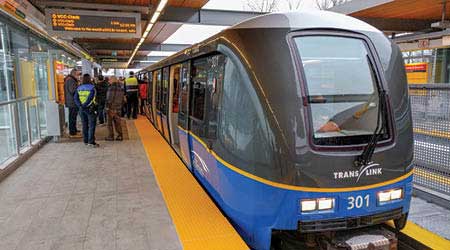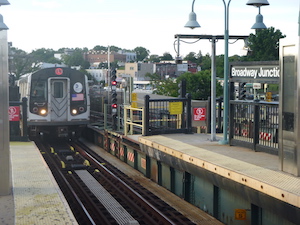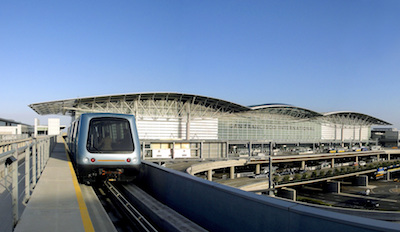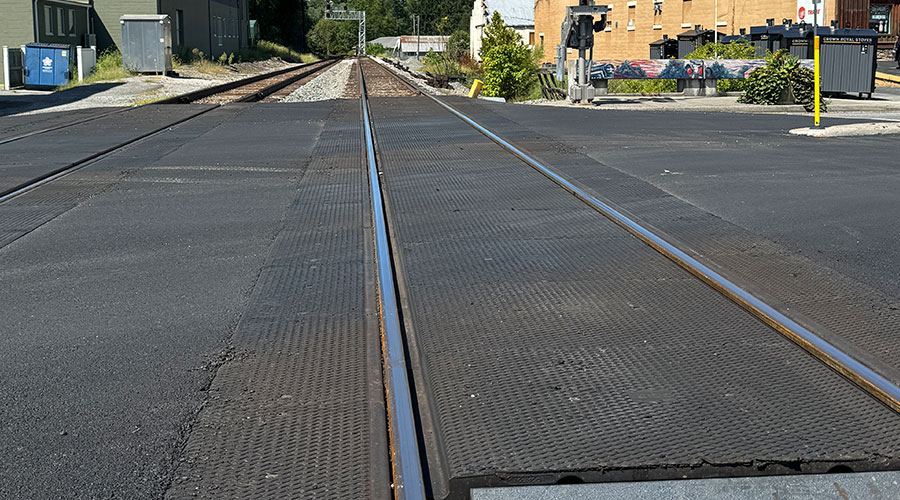Stay updated on news, articles and information for the rail industry
February 2017
Rail News: C&S
Suppliers enhance CBTC systems to function in a more complex rail environment

By Jeff Stagl, Managing Editor
A train-control technology that’s been employed in North America for more than 30 years is becoming a bit more high-tech. Categorized as communications-based train control (CBTC), it also is evolving into a signaling option for both passenger and freight railroads.
CBTC is an automated system that employs continuous, bidirectional train-to-wayside communications to monitor a train’s location and ensure the safe operation of rail vehicles. It differs from conventional signaling by determining a train’s location independent of track circuits via transponder tags or beacons installed along a wayside.
To date, CBTC is employed at a dozen or so passenger railroads and airport trams, while several others in the North American rail industry are considering whether to adopt it.
To help more railroads meet today’s demanding operational challenges — including the addition of positive train control (PTC) — several suppliers are trying to enhance their CBTC systems for increasingly complex rail environments. In addition, others are working to develop and market their system for broader rail industry applications.
Count Siemens among those pursuing system enhancements. The radio and Automatic Train Supervision (ATS) aspects of its Trainguard MT CBTC system are maturing to better provide the functionality transit agencies need, says Bill Conis, director of business development for Siemens Mobility.
Trainguard MT is designed to operate at different train-control levels, handle trains with different train control equipment at the same time in the same network, and help reduce lifecycle costs by minimizing the number of outdoor elements and maximizing energy efficiency.
Since there are growing concerns in the passenger-rail industry about computer hacking, Siemens recommends that transit agencies use a licensed radio band for their CBTC system instead of a proprietary radio — they need to “stay away from public Wi-Fi bands,” Conis says.
“I think more agencies in the future will go with a licensed band. It’s not expensive and you don’t need a lot of bandwidth,” he adds. “It’s critical to ensure others won’t hack your system.”
In addition, the ATS portion of CBTC now is much more sophisticated, with greater functionality than there was four or five years ago, he says. Recent enhancements include junction and work-zone management, a graphical user interface, and the ability to access a supervisory control and data acquisition system to determine if track is energized or de-energized.
New York state of mind
In terms of ongoing CBTC projects, Siemens continues to work on equipment for MTA New York City Transit’s (NYCT) Queens Boulevard Line (QBL). The transit agency plans to eventually have CBTC systems in place on all of its 24 lines, says NYCT spokesman Kevin Ortiz.
Slated to enter service in 2021, the QBL CBTC system will enable the agency to operate more trains per hour on the underground line between Queens and Manhattan and provide more reliable service.
Last month, RailWorks Corp. subsidiary L.K. Comstock & Co. Inc. won a $223.3 million contract to install CBTC, upgrade signals and complete new systems work on the line.
Siemens will provide 90 percent of the CBTC equipment for the QBL, with the other 10 percent supplied by Thales, says Conis.
 Siemens previously provided the CBTC system for MTA New York City Transit's Canarsie Line. Siemens
Siemens previously provided the CBTC system for MTA New York City Transit's Canarsie Line. Siemens“We’re working together to test interoperability,” he says.
About a decade ago, Siemens provided the CBTC system for NYCT’s Canarsie Line. The company continues to count the agency as a customer in addition to pursuing CBTC projects at the Maryland Transit Administration and Bay Area Rapid Transit, which are in procurement phase, says Conis.
Thales also continues to seek more contracts for its SelTrac® CBTC system, which is designed to be applicable to any type or size of rolling stock and dedicated guideway. SelTrac features built-in flexibility to address the diverse requirements of railroads needing basic automatic train protection, cab signalling or CBTC-based operations.
Thales is finishing up CBTC procurement for NYCT’s No. 7 Flushing Line; the system is slated to enter service later this year.
The company also is providing a SelTrac system for the San Francisco Municipal Transportation Agency’s Central Subway, which is expected to enter revenue service sometime this year, and OC Transpo’s O-Train Confederation Line in Ottawa, Canada. The OC Transpo light-rail route — which will connect to the Tunney’s Pasture Station in the west and Blair Road in the east — is scheduled to open next year.
In addition, Thales is modernizing the control system for West Virginia University’s personal rapid transit (PRT) system with its radio-based SelTrac technology. Originally equipped with a roadbed resident audio frequency control solution by Boeing in the 1970s, the PRT will feature Thales' 2.4 GHz wireless-based train control technology to boost operational reliability. The company also will modernize the PRT control room with a PC/IP-based management network.
Thales invented and commercialized CBTC in the 1980s, says spokesman Conrad Bellehumeur. To date, SelTrac has been installed on about 1,500 miles of subway and light-rail lines in 40 major cities.
Late last year, Thales completed a large CBTC project for TransLink in Vancouver, British Columbia. On Dec. 2, the agency opened the Evergreen extension of SkyTrain’s Millennium Line that features the SelTrac system. The opening marked the seventh extension to the SkyTrain network — which is entirely SelTrac-equipped — since the original Expo Line launched in 1985.
On 80 lines in 40 cities
Meanwhile, Alstom Transport continues to seek more customers for its Urbalis CBTC system, which is designed to interface with all types and suppliers of rolling stock to reach optimal automatic train operation (ATO) performances in terms of control and stopping precision. Since Alstom installed the first Urbalis system in Singapore in 2003, it has equipped 80 metro lines in 40 cities around the world with the CBTC solution. By 2018, more than 1,200 miles of lines and more than 2,000 trains will be equipped with Urbalis, said Nicholas Columbare, Alstom’s transit solutions director-North America, in an email.
The company recently completed the following additions to traditional CBTC: automatic coupling in nominal and rescue modes; more efficient recovery modes in case of software crashes, such as the remote reset of automatic train control computers; better energy management by optimizing train synchronization at peak hours and more energy efficient speed profiles at off-peak hours; more efficient crisis management tools in integrated control centers; and redesigned hardware and software platforms for higher availability and better performance.
In 2013, Alstom introduced Urbalis Fluence, an urban CBTC signaling system targeting performance and optimization. Urbalis Fluence’s architecture is designed to optimize train movement flexibility and provide higher operational availability while reducing the overall equipment required compared with non-train-centric CBTC solutions or conventional signaling, said Columbare. Thus, maintenance costs can be lowered over the life of the system, he added.
Bombardier Transportation also continues to develop and refine its CBTC solutions. The firm has been active in the sector since the 1990s, when it developed the first moving-block CBTC signaling products for mass transit, automated people mover (APM) and monorail applications, Bombardier officials said in an email. The company’s CITYFLO 650 CBTC system has been deployed on more than 35 lines globally since it first was installed at San Francisco International Airport in 2003.
 Bombardier is upgrading its CBTC system that was deployed for a tram at San Francisco International Airport in 2003. Bombardier Transportation
Bombardier is upgrading its CBTC system that was deployed for a tram at San Francisco International Airport in 2003. Bombardier TransportationThat S.F. airport deployment now is being upgraded and expanded, and will include many enhancements to the CITYFLO 650 system, such as updates to the next-generation train-to-wayside communication system, Bombardier officials said. The wired network that was based on a fiber distributed data interface is being replaced with a higher-speed gigabit ethernet network. Bombardier also is making modifications to the handling of any communication failures with the train to improve automatic service recovery.
Putting telecommunications to the test
Bombardier has tested the CITYFLO 650 system with the latest 4G LTE telecommunications networks, which offer the option to merge all communications with the train — voice, infotainment, closed-circuit TV (CCTV) and safety critical data — into the latest, single, high-capacity wireless system.
“This results in reduced wayside equipment and increased efficiency, and enables rail operators to provide a broad range of value-add services to passengers,” Bombardier officials said.
Last year, the company won a contract to implement the CITYFLO 650 system on the Eglinton light-rail line in Toronto. The system will be unique because it will incorporate three levels of automation: manual and automatic train protection (ATP) along street areas, ATO in the tunnel and unattended train operations in the yard, Bombardier officials said.
In terms of urban rail-control solutions utilizing CBTC, the company also offers a CITYFLO 150 signaling system for trams and light rail. The system, which employs CBTC functionality, offers main features that include support for on-street and segregated driving and train tracking via GPS.
Ansaldo STS is working to upgrade and enhance its CBTC system, too. The company is migrating to the latest generation of user interface for the control center aspect of the system to include upgraded features, implementing additional layers of security and developing a new suite of performance modeling tools.
For the onboard aspect, Ansaldo is creating uniform, standardized packaging and interfaces to provide customers quicker implementation time and a lower cost. The company also is investigating other technologies to enhance its odometry, which will help lower equipment cost and increase overall performance, Ansaldo STS officials said in an email.
A stand-alone solution
For Wabtec Corp., recent efforts have focused on expanding its I-ETMS train-control solution into traditional CBTC applications as the system’s installation base and capabilities continue to expand. The PTC system of choice for many freight and commuter railroads, I-ETMS has grown to support CBTC applications for those railroads via the integration of on-board, wayside and office systems over multiple communications networks, Wabtec officials said in an email.
Wabtec is working to extend I-ETMS into a vital standalone train-control solution that will provide the capability to implement moving block operations through the installed base of 23,000 I-ETMS-equipped locomotives in the United States. Those efforts include upgrades to existing related products, including crash-hardened HD video and end-of-train telemetry systems. The vital standalone system will be offered in North American and international markets to address emerging CBTC needs without the need for extensive wayside equipment, Wabtec officials said.
The company has applied a modified version of I-ETMS as part of a CBTC solution for Brazil’s MRS Logistica S.A. that also included new voice and data radio communications, office and wayside signal systems. The solution is operating on 1,000 miles of the freight railroad’s network and 500 of its locomotives.
The existing interoperable I-ETMS system provides ATP as part of its core feature set and supports ATO through the complete integration of two third-party vendor applications into the I-ETMS train management computer, Wabtec officials said. That enables synchronization of the onboard track database, navigation, wayside and control setting status to provide automatic I-ETMS train operation with both acceleration and dynamic braking functions.
While Wabtec has broadened its PTC system for CBTC applications, Siemens has developed a PTC system based on its Trainguard MT CBTC platform. Siemens also has continued helping transit agencies work toward something that’s becoming popular as they employ CBTC with or without PTC.
“The trend is to start eliminating track circuits,” says Siemens Mobility’s Conis.


 LRW Honors Amtrak’s Acheson As Railway Woman Of The Year
LRW Honors Amtrak’s Acheson As Railway Woman Of The Year
 From Editor-In-Chief Foran: Of Gender Equity And Inclusion
From Editor-In-Chief Foran: Of Gender Equity And Inclusion
 Spotlight On Some Of Today’s Rail Safety Products
Spotlight On Some Of Today’s Rail Safety Products
 Women of Influence in Rail eBook
Women of Influence in Rail eBook
 railPrime
railPrime







